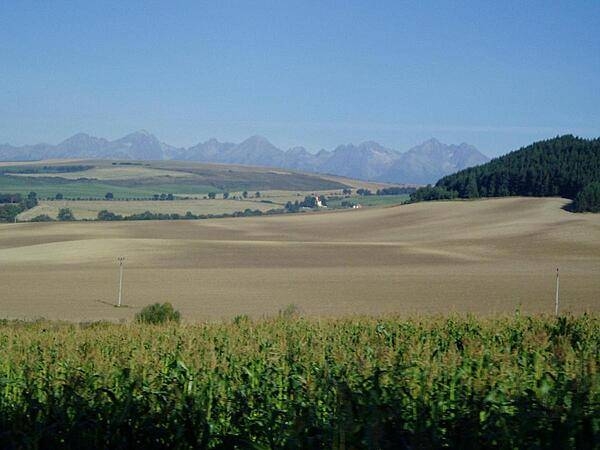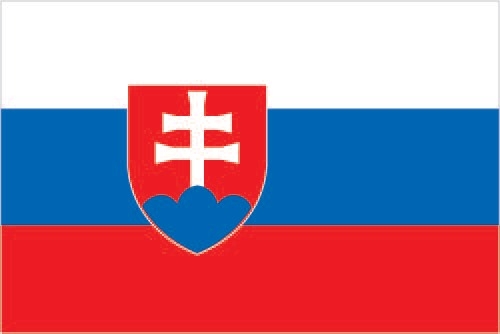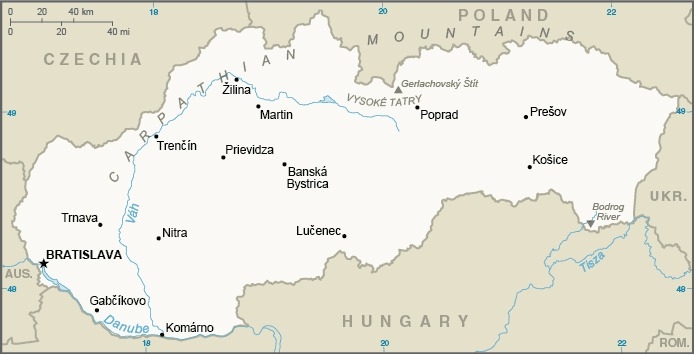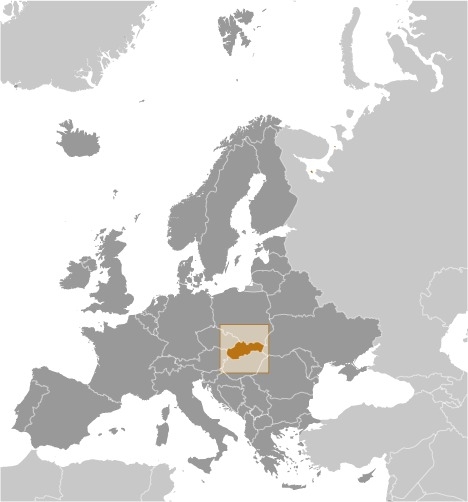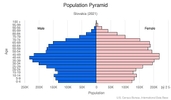Slovakia
Introduction
Background
Slovakia traces its roots to the 9th century state of Great Moravia. Subsequently, the Slovaks became part of the Hungarian Kingdom, where they remained for the next 1,000 years. After the formation of the dual Austro-Hungarian monarchy in 1867, backlash to language and education policies favoring the use of Hungarian (Magyarization) encouraged the strengthening of Slovak nationalism and a cultivation of cultural ties with the closely related Czechs, who fell administratively under the Austrian half of the empire. After the dissolution of the Austro-Hungarian Empire at the close of World War I, the Slovaks joined the Czechs to form Czechoslovakia. The new state was envisioned as a nation with Czech and Slovak branches. During the interwar period, Slovak nationalist leaders pushed for autonomy within Czechoslovakia, and in 1939 Slovakia became an independent state created by and allied with Nazi Germany. Following World War II, Czechoslovakia was reconstituted and came under communist rule within Soviet-dominated Eastern Europe. In 1968, an invasion by Warsaw Pact troops ended the efforts of Czechoslovakia's leaders to liberalize communist rule and create "socialism with a human face," ushering in a period of repression known as "normalization." The peaceful "Velvet Revolution" swept the Communist Party from power at the end of 1989 and inaugurated a return to democratic rule and a market economy. On 1 January 1993, Czechoslovakia underwent a nonviolent "velvet divorce" into its two national components, Slovakia and the Czech Republic. Slovakia joined both NATO and the EU in the spring of 2004 and the euro zone on 1 January 2009.
Visit the Definitions and Notes page to view a description of each topic.
Geography
Location
Central Europe, south of Poland
Geographic coordinates
48 40 N, 19 30 E
Map references
Europe
Area - comparative
about one and a half times the size of Maryland; about twice the size of New Hampshire
Land boundaries
total: 1,587 km
border countries (5): Austria 105 km, Czechia 241 km, Hungary 627 km, Poland 517 km, Ukraine 97 km
Coastline
0 km (landlocked)
Maritime claims
none (landlocked)
Climate
temperate; cool summers; cold, cloudy, humid winters
Terrain
rugged mountains in the central and northern part and lowlands in the south
Elevation
highest point: Gerlachovsky Stit 2,655 m
lowest point: Bodrok River 94 m
mean elevation: 458 m
Natural resources
lignite, small amounts of iron ore, copper and manganese ore; salt; arable land
Land use
agricultural land: 40.1% (2018 est.)
arable land: 28.9% (2018 est.)
permanent crops: 0.4% (2018 est.)
permanent pasture: 10.8% (2018 est.)
forest: 40.2% (2018 est.)
other: 19.7% (2018 est.)
Irrigated land
869 sq km (2012)
Major watersheds (area sq km)
Atlantic Ocean drainage: (Black Sea) Danube (795,656 sq km)
Major rivers (by length in km)
Danube (shared with Germany [s], Austria, Hungary, Croatia, Serbia, Bulgaria, Ukraine, Moldova, and Romania [m]) - 2,888 km
note – [s] after country name indicates river source; [m] after country name indicates river mouth
Population distribution
a fairly even distribution throughout most of the country; slightly larger concentration in the west in proximity to the Czech border
Natural hazards
flooding
Geography - note
landlocked; most of the country is rugged and mountainous; the Tatra Mountains in the north are interspersed with many scenic lakes and valleys
People and Society
Nationality
noun: Slovak(s)
adjective: Slovak
Ethnic groups
Slovak 80.7%, Hungarian 8.5%, Romani 2%, other 1.8% (includes Czech, Ruthenian, Ukrainian, Russian, German, Polish), unspecified 7% (2011 est.)
note: data represent population by nationality; Romani populations are usually underestimated in official statistics and may represent 7–11% of Slovakia's population
Languages
Slovak (official) 78.6%, Hungarian 9.4%, Roma 2.3%, Ruthenian 1%, other or unspecified 8.8% (2011 est.)
major-language sample(s):
Svetova Kniha Faktov, nenahraditelny zdroj zakladnej informacie. (Slovak)
The World Factbook, the indispensable source for basic information.
Religions
Roman Catholic 62%, Protestant 8.2%, Greek Catholic 3.8%, other or unspecified 12.5%, none 13.4% (2011 est.)
Age structure
0-14 years: 15.13% (male 423,180/female 400,128)
15-24 years: 10.06% (male 280,284/female 266,838)
25-54 years: 44.61% (male 1,228,462/female 1,198,747)
55-64 years: 13.15% (male 342,124/female 373,452)
65 years and over: 17.05% (male 366,267/female 561,120) (2020 est.)
Dependency ratios
total dependency ratio: 47.6
youth dependency ratio: 23
elderly dependency ratio: 24.6
potential support ratio: 4.1 (2020 est.)
Median age
total: 41.8 years
male: 40.1 years
female: 43.6 years (2020 est.)
Population distribution
a fairly even distribution throughout most of the country; slightly larger concentration in the west in proximity to the Czech border
Urbanization
urban population: 53.8% of total population (2021)
rate of urbanization: 0.17% annual rate of change (2020-25 est.)
Major urban areas - population
437,000 BRATISLAVA (capital) (2021)
Sex ratio
at birth: 1.07 male(s)/female
0-14 years: 1.06 male(s)/female
15-24 years: 1.05 male(s)/female
25-54 years: 1.02 male(s)/female
55-64 years: 0.92 male(s)/female
65 years and over: 0.65 male(s)/female
total population: 0.94 male(s)/female (2020 est.)
Mother's mean age at first birth
27.2 years (2019 est.)
Maternal mortality ratio
5 deaths/100,000 live births (2017 est.)
country comparison to the world: 170Infant mortality rate
total: 4.9 deaths/1,000 live births
male: 5.56 deaths/1,000 live births
female: 4.2 deaths/1,000 live births (2021 est.)
Life expectancy at birth
total population: 78.07 years
male: 74.56 years
female: 81.82 years (2021 est.)
Drinking water source
improved: urban: 100% of population
rural: 100% of population
total: 100% of population
unimproved: urban: 0% of population
rural: 0% of population
total: 0% of population (2017 est.)
Current Health Expenditure
6.7% (2018)
Physicians density
3.42 physicians/1,000 population (2017)
Hospital bed density
5.7 beds/1,000 population (2018)
Sanitation facility access
improved: urban: 99.9% of population
rural: 100% of population
total: 100% of population
unimproved: urban: 0.1% of population
rural: 0% of population
total: 0% of population (2017 est.)
HIV/AIDS - adult prevalence rate
<.1% (2018 est.)
HIV/AIDS - deaths
<100 (2018 est.)
School life expectancy (primary to tertiary education)
total: 15 years
male: 14 years
female: 15 years (2019)
Unemployment, youth ages 15-24
total: 19.4%
male: 18.3%
female: 21.2% (2020 est.)
Environment
Environment - current issues
air pollution and acid rain present human health risks and damage forests; land erosion caused by agricultural and mining practices; water pollution
Environment - international agreements
party to: Air Pollution, Air Pollution-Heavy Metals, Air Pollution-Multi-effect Protocol, Air Pollution-Nitrogen Oxides, Air Pollution-Persistent Organic Pollutants, Air Pollution-Sulphur 85, Air Pollution-Sulphur 94, Air Pollution-Volatile Organic Compounds, Antarctic Treaty, Biodiversity, Climate Change, Climate Change-Kyoto Protocol, Climate Change-Paris Agreement, Comprehensive Nuclear Test Ban, Desertification, Endangered Species, Environmental Modification, Hazardous Wastes, Law of the Sea, Nuclear Test Ban, Ozone Layer Protection, Ship Pollution, Tropical Timber 2006, Wetlands, Whaling
signed, but not ratified: Antarctic-Environmental Protection
Air pollutants
particulate matter emissions: 17.54 micrograms per cubic meter (2016 est.)
carbon dioxide emissions: 32.42 megatons (2016 est.)
methane emissions: 4.43 megatons (2020 est.)
Climate
temperate; cool summers; cold, cloudy, humid winters
Land use
agricultural land: 40.1% (2018 est.)
arable land: 28.9% (2018 est.)
permanent crops: 0.4% (2018 est.)
permanent pasture: 10.8% (2018 est.)
forest: 40.2% (2018 est.)
other: 19.7% (2018 est.)
Urbanization
urban population: 53.8% of total population (2021)
rate of urbanization: 0.17% annual rate of change (2020-25 est.)
Revenue from forest resources
forest revenues: 0.22% of GDP (2018 est.)
country comparison to the world: 90Waste and recycling
municipal solid waste generated annually: 1.784 million tons (2015 est.)
municipal solid waste recycled annually: 135,941 tons (2015 est.)
percent of municipal solid waste recycled: 7.6% (2015 est.)
Major rivers (by length in km)
Danube (shared with Germany [s], Austria, Hungary, Croatia, Serbia, Bulgaria, Ukraine, Moldova, and Romania [m]) - 2,888 km
note – [s] after country name indicates river source; [m] after country name indicates river mouth
Major watersheds (area sq km)
Atlantic Ocean drainage: (Black Sea) Danube (795,656 sq km)
Total water withdrawal
municipal: 293.5 million cubic meters (2017 est.)
industrial: 231.2 million cubic meters (2017 est.)
agricultural: 31.6 million cubic meters (2017 est.)
Total renewable water resources
50.1 billion cubic meters (2017 est.)
Government
Country name
conventional long form: Slovak Republic
conventional short form: Slovakia
local long form: Slovenska republika
local short form: Slovensko
etymology: may derive from the medieval Latin word "Slavus" (Slav), which had the local form "Sloven", used since the 13th century to refer to the territory of Slovakia and its inhabitants
Government type
parliamentary republic
Capital
name: Bratislava
geographic coordinates: 48 09 N, 17 07 E
time difference: UTC+1 (6 hours ahead of Washington, DC, during Standard Time)
daylight saving time: +1hr, begins last Sunday in March; ends last Sunday in October
etymology: the name was adopted in 1919 after Czechoslovakia gained its independence and may derive from later transliterations of the 9th century military commander, Braslav, or the 11th century Bohemian Duke Bretislav I; alternatively, the name may derive from the Slovak words "brat" (brother) and "slava" (glory)
Administrative divisions
8 regions (kraje, singular - kraj); Banska Bystrica, Bratislava, Kosice, Nitra, Presov, Trencin, Trnava, Zilina
Independence
1 January 1993 (Czechoslovakia split into the Czech Republic and Slovakia)
National holiday
Constitution Day, 1 September (1992)
Constitution
history: several previous (preindependence); latest passed by the National Council 1 September 1992, signed 3 September 1992, effective 1 October 1992
amendments: proposed by the National Council; passage requires at least three-fifths majority vote of Council members; amended many times, last in 2020
Legal system
civil law system based on Austro-Hungarian codes; note - legal code modified to comply with the obligations of Organization on Security and Cooperation in Europe
International law organization participation
accepts compulsory ICJ jurisdiction with reservations; accepts ICCt jurisdiction
Citizenship
citizenship by birth: no
citizenship by descent only: at least one parent must be a citizen of Slovakia
dual citizenship recognized: no
residency requirement for naturalization: 5 years
Suffrage
18 years of age; universal
Executive branch
chief of state: President Zuzana CAPUTOVA (since 15 June 2019)
head of government: Prime Minister Eduard HEGER (since 1 April 2021); Deputy Prime Ministers Stefan HOLY, Veronika REMISOVA, Richard SULIK (all since 21 March 2020)
cabinet: Cabinet appointed by the president on the recommendation of the prime minister
elections/appointments: president directly elected by absolute majority popular vote in 2 rounds if needed for a 5-year term (eligible for a second term); election last held on 16 March and 30 March 2019 (next to be held March 2024); following National Council elections (every 4 years), the president designates a prime minister candidate, usually the leader of the party or coalition that wins the most votes, who must win a vote of confidence in the National Council
election results:
2019: Zuzana CAPUTOVA reelected president in second round; percent of vote - Zuzana CAPUTOVA (PS) 58.4%, Maros SEFCOVIC (independent) 41.6%
2014: Andrej KISKA elected president in second round; percent of vote - Andrej KISKA (independent) 59.4%, Robert FICO (Smer-SD) 40.6%
Legislative branch
description: unicameral National Council or Narodna Rada (150 seats; members directly elected in a single- and multi-seat constituencies by closed, party-list proportional representation vote; members serve 4-year terms)
elections: last held on 29 February 2020 (next to be held March 2024)
election results: percent of vote by party - OLaNO-NOVA 25%, Smer-SD 18.3%, Sme-Rodina 8.2%, LSNS 8%, PS-SPOLU 7%, SaS 6.2%, Za Ludi 5.8%, other 21.5%; seats by party - OLaNO-NOVA 53, Smer-SD 38, Sme-Rodina 17, LSNS 17, SaS 13, Za Ludi 12, PS-SPOLU 0; composition - men 120, women 30, percent of women 20%
Judicial branch
highest courts: Supreme Court of the Slovak Republic (consists of the court president, vice president, and approximately 80 judges organized into criminal, civil, commercial, and administrative divisions with 3- and 5-judge panels); Constitutional Court of the Slovak Republic (consists of 13 judges organized into 3-judge panels)
judge selection and term of office: Supreme Court judge candidates nominated by the Judicial Council of the Slovak Republic, an 18-member self-governing body that includes the Supreme Court chief justice and presidential, governmental, parliamentary, and judiciary appointees; judges appointed by the president serve for life subject to removal by the president at age 65; Constitutional Court judges nominated by the National Council of the Republic and appointed by the president; judges serve 12-year terms
subordinate courts: regional and district civil courts; Special Criminal Court; Higher Military Court; military district courts; Court of Audit;
Political parties and leaders
Alliance-Szovetseg [Krisztian FORRO]
Direction-Social Democracy or Smer-SD [Robert FICO]
For the People or Za Ludi [Veronika REMISOVA]
Freedom and Solidarity or SaS [Richard SULIK]
Kotleba-People's Party Our Slovakia or LSNS [Marian KOTLEBA]
Ordinary People and Independent Personalities - New Majority or OLaNO-NOVA [Igor MATOVIC]
Slovak National Party or SNS [Andrej DANKO]
Voice or Hlas-SD [Petr PELLIGRINI]
We Are Family or Sme-Rodina [Boris KOLLAR]
International organization participation
Australia Group, BIS, BSEC (observer), CBSS (observer), CD, CE, CEI, CERN, EAPC, EBRD, ECB, EIB, EMU, EU, FAO, IAEA, IBRD, ICAO, ICC (national committees), ICRM, IDA, IEA, IFC, IFRCS, ILO, IMF, IMO, IMSO, Interpol, IOC, IOM, IPU, ISO, ITU, ITUC (NGOs), MIGA, NATO, NEA, NSG, OAS (observer), OECD, OIF (observer), OPCW, OSCE, PCA, Schengen Convention, SELEC (observer), UN, UNCTAD, UNESCO, UNFICYP, UNIDO, UNTSO, UNWTO, UPU, WCO, WFTU (NGOs), WHO, WIPO, WMO, WTO, ZC
Diplomatic representation in the US
chief of mission: Ambassador Radovan JAVORCIK (since 18 January 2021)
chancery: 3523 International Court NW, Washington, DC 20008
telephone: [1] (202) 237-1054
FAX: [1] (202) 237-6438
email address and website:
emb.washington@mzv.sk
https://www.mzv.sk/web/washington-en
consulate(s) general: Los Angeles, New York
Diplomatic representation from the US
chief of mission: Ambassador Bridget A. BRINK (since 20 August 2019)
embassy: P.O. Box 309, 814 99 Bratislava
mailing address: 5840 Bratislava Place, Washington DC 20521-5840
telephone: [421] (2) 5443-3338
FAX: [421] (2) 5441-8861
email address and website:
consulbratislava@state.gov
https://sk.usembassy.gov/
Flag description
three equal horizontal bands of white (top), blue, and red derive from the Pan-Slav colors; the Slovakian coat of arms (consisting of a red shield bordered in white and bearing a white double-barred cross of St. Cyril and St. Methodius surmounting three blue hills) is centered over the bands but offset slightly to the hoist side
note: the Pan-Slav colors were inspired by the 19th-century flag of Russia
National symbol(s)
double-barred cross (Cross of St. Cyril and St. Methodius) surmounting three peaks; national colors: white, blue, red
National anthem
name: "Nad Tatrou sa blyska" (Lightning Over the Tatras)
lyrics/music: Janko MATUSKA/traditional
note: adopted 1993, in use since 1844; music based on the Slovak folk song "Kopala studienku"
Economy
Economic overview
Slovakia’s economy suffered from a slow start in the first years after its separation from the Czech Republic in 1993, due to the country’s authoritarian leadership and high levels of corruption, but economic reforms implemented after 1998 have placed Slovakia on a path of strong growth. With a population of 5.4 million, the Slovak Republic has a small, open economy driven mainly by automobile and electronics exports, which account for more than 80% of GDP. Slovakia joined the EU in 2004 and the euro zone in 2009. The country’s banking sector is sound and predominantly foreign owned.
Slovakia has been a regional FDI champion for several years, attractive due to a relatively low-cost yet skilled labor force, and a favorable geographic location in the heart of Central Europe. Exports and investment have been key drivers of Slovakia’s robust growth in recent years. The unemployment rate fell to historical lows in 2017, and rising wages fueled increased consumption, which played a more prominent role in 2017 GDP growth. A favorable outlook for the Eurozone suggests continued strong growth prospects for Slovakia during the next few years, although inflation is also expected to pick up.
Among the most pressing domestic issues potentially threatening the attractiveness of the Slovak market are shortages in the qualified labor force, persistent corruption issues, and an inadequate judiciary, as well as a slow transition to an innovation-based economy. The energy sector in particular is characterized by unpredictable regulatory oversight and high costs, in part driven by government interference in regulated tariffs. Moreover, the government’s attempts to maintain low household energy prices could harm the profitability of domestic energy firms while undercutting energy efficiency initiatives.
Real GDP (purchasing power parity)
$165.57 billion note: data are in 2017 dollars (2020 est.)
$173.83 billion note: data are in 2017 dollars (2019 est.)
$169.57 billion note: data are in 2017 dollars (2018 est.)
note: data are in 2010 dollars
Real GDP growth rate
2.4% (2019 est.)
3.9% (2018 est.)
3.04% (2017 est.)
Real GDP per capita
$30,300 note: data are in 2017 dollars (2020 est.)
$31,900 note: data are in 2017 dollars (2019 est.)
$31,100 note: data are in 2017 dollars (2018 est.)
note: data are in 2010 dollars
GDP (official exchange rate)
$105.388 billion (2019 est.)
Inflation rate (consumer prices)
2.6% (2019 est.)
2.5% (2018 est.)
1.3% (2017 est.)
Credit ratings
Fitch rating: A (2020)
Moody's rating: A2 (2012)
Standard & Poors rating: A+ (2015)
GDP - composition, by sector of origin
agriculture: 3.8% (2017 est.)
industry: 35% (2017 est.)
services: 61.2% (2017 est.)
GDP - composition, by end use
household consumption: 54.7% (2017 est.)
government consumption: 19.2% (2017 est.)
investment in fixed capital: 21.2% (2017 est.)
investment in inventories: 1.2% (2017 est.)
exports of goods and services: 96.3% (2017 est.)
imports of goods and services: -92.9% (2017 est.)
Agricultural products
wheat, maize, sugar beet, milk, barley, rapeseed, potatoes, sunflower seed, soybeans, pork
Industries
automobiles; metal and metal products; electricity, gas, coke, oil, nuclear fuel; chemicals, synthetic fibers, wood and paper products; machinery; earthenware and ceramics; textiles; electrical and optical apparatus; rubber products; food and beverages; pharmaceutical
Labor force - by occupation
agriculture: 3.9%
industry: 22.7%
services: 73.4% (2015)
Population below poverty line
11.9% (2018 est.)
Gini Index coefficient - distribution of family income
25.2 (2016 est.)
26.1 (2014)
Household income or consumption by percentage share
lowest 10%: 3.3%
highest 10%: 19.3% (2015 est.)
Budget
revenues: 37.79 billion (2017 est.)
expenditures: 38.79 billion (2017 est.)
Public debt
50.9% of GDP (2017 est.)
51.8% of GDP (2016 est.)
note: data cover general Government Gross Debt and include debt instruments issued (or owned) by Government entities, including sub-sectors of central, state, local government, and social security funds
Fiscal year
calendar year
Current account balance
-$3.026 billion (2019 est.)
-$2.635 billion (2018 est.)
Exports
$89.92 billion note: data are in current year dollars (2020 est.)
$97.04 billion note: data are in current year dollars (2019 est.)
$100.76 billion note: data are in current year dollars (2018 est.)
Exports - partners
Germany 22%, Czechia 11%, Poland 7%, France 7%, Hungary 6%, Austria 5%, United Kingdom 5% (2019)
Exports - commodities
cars and vehicle parts, video displays, broadcasting equipment, tires, refined petroleum (2019)
Imports
$87.95 billion note: data are in current year dollars (2020 est.)
$96.75 billion note: data are in current year dollars (2019 est.)
$99.92 billion note: data are in current year dollars (2018 est.)
Imports - partners
Germany 18%, Czechia 18%, Poland 8%, Hungary 7%, Russia 5% (2019)
Imports - commodities
cars and vehicle parts, broadcasting equipment, crude petroleum, natural gas, insulated wiring (2019)
Reserves of foreign exchange and gold
$3.622 billion (31 December 2017 est.)
$2.892 billion (31 December 2016 est.)
Debt - external
$115.853 billion (2019 est.)
$114.224 billion (2018 est.)
Exchange rates
euros (EUR) per US dollar -
0.82771 (2020 est.)
0.90338 (2019 est.)
0.87789 (2018 est.)
0.885 (2014 est.)
0.7634 (2013 est.)
Unemployment, youth ages 15-24
total: 19.4%
male: 18.3%
female: 21.2% (2020 est.)
Energy
Electricity access
electrification - total population: 100% (2020)
Electricity - installed generating capacity
7.644 million kW (2016 est.)
country comparison to the world: 72Electricity - from fossil fuels
36% of total installed capacity (2016 est.)
country comparison to the world: 176Electricity - from nuclear fuels
27% of total installed capacity (2017 est.)
country comparison to the world: 3Electricity - from hydroelectric plants
24% of total installed capacity (2017 est.)
country comparison to the world: 81Electricity - from other renewable sources
13% of total installed capacity (2017 est.)
country comparison to the world: 69Refined petroleum products - production
131,300 bbl/day (2017 est.)
country comparison to the world: 64Refined petroleum products - consumption
85,880 bbl/day (2017 est.)
country comparison to the world: 85Natural gas - proved reserves
14.16 billion cu m (1 January 2018 est.)
country comparison to the world: 75Communications
Telephones - fixed lines
total subscriptions: 616,148 (2020)
subscriptions per 100 inhabitants: 11.29 (2020 est.)
Telephones - mobile cellular
total subscriptions: 7,289,707 (2020)
subscriptions per 100 inhabitants: 133.5 (2020 est.)
Telecommunication systems
general assessment: a modern telecom system; one operator has near monopoly of fixed-line market; competition in mobile- and fixed-broadband market; broadband growth in recent years; competition among DSL, cable, and fiber platforms; FttP growth in cities; operator launched 1Gb/s cable broadband service in 3 cities and 200,000 premises in 2019; EU funding for development and improvement of e-government and online services; regulator prepared groundwork for 5G services in 2020 (2020)
domestic: four companies have a license to operate cellular networks and provide nationwide cellular services; a few other companies provide services but do not have their own networks; fixed-line 12 per 100 and mobile-cellular 136 per 100 teledensity (2019)
international: country code - 421; 3 international exchanges (1 in Bratislava and 2 in Banska Bystrica) are available; Slovakia is participating in several international telecommunications projects that will increase the availability of external services; connects to DREAM cable (2017)
note: the COVID-19 pandemic continues to have a significant impact on production and supply chains globally; since 2020, some aspects of the telecom sector have experienced downturn, particularly in mobile device production; many network operators delayed upgrades to infrastructure; progress towards 5G implementation was postponed or slowed in some countries; consumer spending on telecom services and devices was affected by large-scale job losses and the consequent restriction on disposable incomes; the crucial nature of telecom services as a tool for work and school from home became evident, and received some support from governments
Broadcast media
state-owned public broadcaster, Radio and Television of Slovakia (RTVS), operates 2 national TV stations and multiple national and regional radio networks; roughly 50 privately owned TV stations operating nationally, regionally, and locally; about 40% of households are connected to multi-channel cable or satellite TV; 32 privately owned radio stations
Internet users
total: 4.64 million (2021 est.)
percent of population: 89.92% (2020 est.)
Broadband - fixed subscriptions
total: 1,701,561 (2020)
subscriptions per 100 inhabitants: 31.17 (2020 est.)
Transportation
National air transport system
number of registered air carriers: 4 (2020)
inventory of registered aircraft operated by air carriers: 45
Airports - with paved runways
total: 19
over 3,047 m: 2
2,438 to 3,047 m: 2
1,524 to 2,437 m: 3
914 to 1,523 m: 3
under 914 m: 9 (2019)
Airports - with unpaved runways
total: 15
914 to 1,523 m: 10
under 914 m: 5 (2019)
Heliports
1 (2019)
Pipelines
2270 km gas transmission pipelines, 6278 km high-pressure gas distribution pipelines, 27023 km mid- and low-pressure gas distribution pipelines (2016), 510 km oil (2015)
Railways
total: 3,580 km (2016)
standard gauge: 3,435 km 1.435-m gauge (1,587 km electrified) (2016)
narrow gauge: 46 km 1.000-m or 0.750-m gauge (2016)
broad gauge: 99 km 1.520-m gauge (2016)
Roadways
total: 56,926 km (includes local roads, national roads, and 464 km of highways) (2016)
country comparison to the world: 81Ports and terminals
river port(s): Bratislava, Komarno (Danube)
Military and Security
Military and security forces
Armed Forces of the Slovak Republic (Ozbrojene Sily Slovenskej Republiky): Land Forces (Slovenské Pozemné Sily), Air Forces (Slovenské Vzdušné Sily), Special Operations Forces (Sily Pre Speciálne Operácie) (2021)
Military expenditures
1.73% of GDP (2021 est.)
2% of GDP (2020 est.)
1.71% of GDP (2019)
1.23% of GDP (2018)
1.11% of GDP (2017)
Military and security service personnel strengths
the Armed Forces of the Slovak Republic have approximately 13,000 active duty personnel (6,000 Land Forces; 4,000 Air Forces; 3,000 other, including staff, special operations, and support forces) (2021)
Military equipment inventories and acquisitions
the inventory of the Slovakian military consists mostly of Soviet-era platforms; since 2010, it has imported limited quantities of equipment from China, Czechia, Italy, Russia, and the US (2021)
Military deployments
240 Cyprus (UNFICYP); up to 175 Latvia (NATO) (2021)
Military service age and obligation
18-30 years of age for voluntary military service; conscription in peacetime suspended in 2004; women are eligible to serve (2021)
Military - note
Slovakia officially became a member of NATO in 2004
Transnational Issues
Disputes - international
bilateral government, legal, technical and economic working group negotiations continued between Slovakia and Hungary over Hungary's completion of its portion of the Gabcikovo-Nagymaros hydroelectric dam project along the Danube; as a member state that forms part of the EU's external border, Slovakia has implemented strict Schengen border rules
Refugees and internally displaced persons
stateless persons: 1,532 (2020)
Illicit drugs
transshipment point for Southwest Asian heroin bound for Western Europe; producer of synthetic drugs for regional market; consumer of ecstasy
